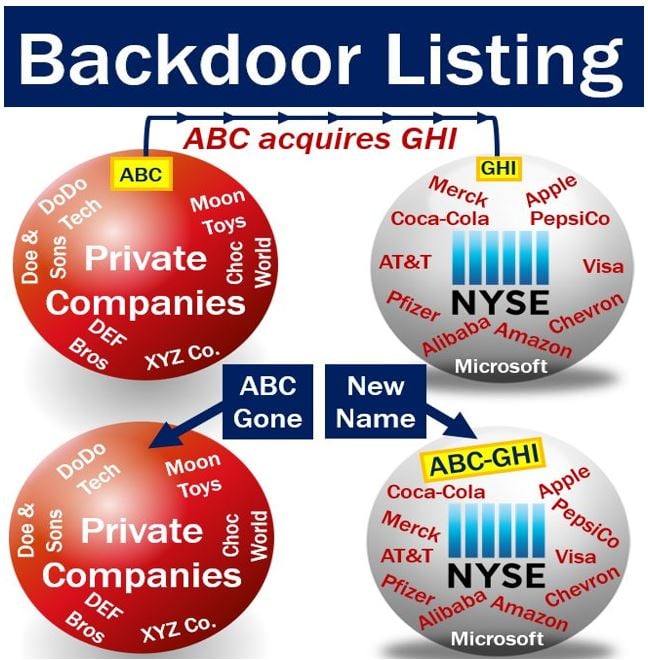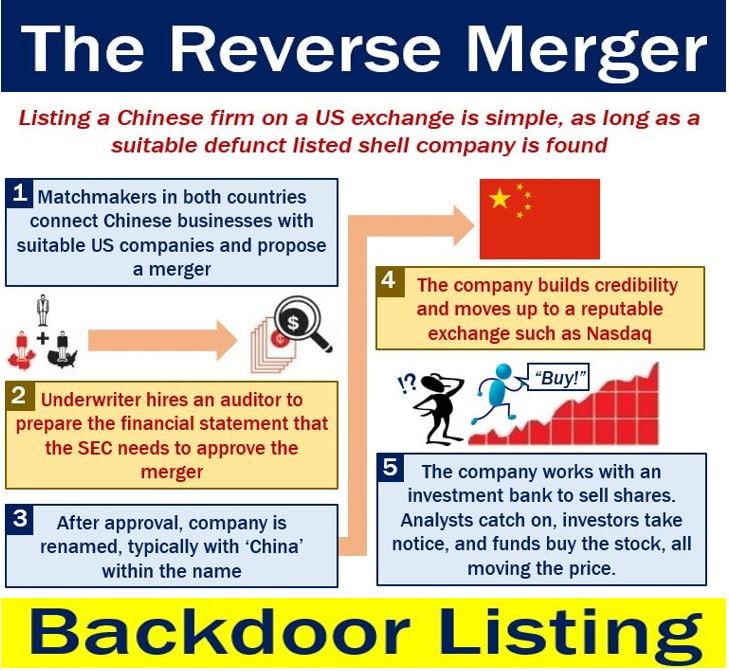Backdoor listing is the process by which a commercial enterprise gets onto a stock exchange listing without an IPO (initial public offering). Put simply; the company gets in ‘through the back door,’ hence the term. This may occur by merging with a public company, or even acquiring it.
The terms reverse takeover, reverse IPO, or reverse merger have the same meaning as backdoor listing.
A private firm that did not succeed in getting onto a stock exchange listing may choose the backdoor option. After the takeover of the public company, the acquirer might merge the operations of the two companies.
Alternatively, the acquiring firm may create a **shell company that allows them to continue doing business independently.
** A shell company or front company, is a company without any significant assets or current business activity. In other words, it is a non-functioning company that is worth very little.
The unlisted firm’s shareholders acquire a major portion of the listed company. However, they can only do this with the consent of the listed company’s stockholders.
Typically, the public company has few assets, little activity, and is no longer viable. When a company is not viable, it is no longer capable of making a profit.
In other words, the private firm looks for a public company that is worthless and buys it.

The private firm’s stockholders get public company shares plus cash in exchange for their share of the acquiring firm. Alternatively, the public company’s shareholders may just get cash.
The benefit for the private firm is clear. It subsequently gains listed status on a stock exchange. For the public company, it could mean its re-emergence as a viable concern.
The two companies do not necessarily need to be compatible. A new tech business might use the shell of a dormant mining company to gain listed status.

Backdoor listing – the process
The shareholders of the private company purchase control of a non-functioning public company. We call this non-functioning business a public shell company. After purchasing a majority interest in the shell company, the private company’s shareholders control its Board of Directors. Majority interest means to have possession of more than 50% of a company’s shares.
As soon as they control the Board, they complete the whole transaction within a few weeks. The private company and the listed shell company exchange information on each other. They then negotiate the terms of the merger or takeover. Finally, they sign a share exchange agreement.
When the transaction closes, the shell company issues a majority of its shares to the private company’s shareholders. Subsequently, the private company has control of the Board.
The private company shareholders bought the shell company with their private company shares. In other words, they contributed their shares to pay for the shell company.
This change of control and share exchange completes the reverse takeover. The result is that the unlisted private company now has a stock market listing.
If the shell company is SEC-registered, the whole process is swift. The private company does not go through the lengthy review with state and federal regulators. It does not need to because this process had been completed in advance with the public company. SEC stands for the US Securities and Exchange Commission.
However, the SEC does require a comprehensive disclosure document containing financial statements. Additionally, the SEC requires significant financial disclosures.
Backdoor listing – some examples
- T-Mobile USA acquired MetroPCS, and after the completion of the takeover changed its name to T-Mobile US. Subsequently, the new entity started trading as TMUS on the NYSE (New York Stock Exchange).
- Clearwire took over Sprint’s Xohm division.
- America West Airlines acquired US Airways. The goal was to remove US Airways from Chapter 11 bankruptcy.
- Matra acquired Aérospatiale to form Aérospatiale-Matra. The aim was to take the former public.
Backdoor listing – pros and cons
Some downsides for shareholders:
- – It is generally more expensive than a comparable IPO.
- – The whole process can take longer than a similar IPO.
- – In some countries, it can result in the temporary suspension of trading of the listed company’s shares.
- – A reverse takeover can be a more complex transaction for stockholders to understand.
- – Some regulations do not allow stockholders to sell their shares within one or two years of the reverse takeover.
Some advantages for shareholders:
- Less need for broad shareholder interest.
- If the two commercial enterprises are running similar businesses, they may not need a prospectus.
- It is much easier to reach the minimum stockholder base.
